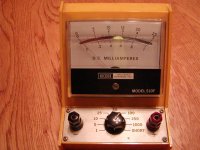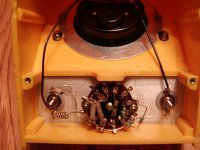I accidentally caused the death of a valued friend by accidentally letting him drop to his death. Yes, my much loved Hickok Model 510F DC Milliamperes meter fell which caused a massive foul up if its hairspring of which I could not make right. Its scales were the result of some engineers love of the game as it once taught in a Community College.
Would it be possible to put another movement in its chassis and once again bring life back to this valued friend? I miss its scales of 1,5,10,50,100,250,1000 and the short across the meter position?
Any help would be much appreciated as I cannot look upon its cold lifeless exterior.
Would it be possible to put another movement in its chassis and once again bring life back to this valued friend? I miss its scales of 1,5,10,50,100,250,1000 and the short across the meter position?
Any help would be much appreciated as I cannot look upon its cold lifeless exterior.
Attachments
Try Electronic Surplus in Cleveland, Ohio:
http://www.electronicsurplus.com/
Their web-page only lists a small part of their stock.
They just moved to a new location this week so they may be somewhat disorganized. Their old location was only a few miles from Hickok.
http://www.electronicsurplus.com/
Their web-page only lists a small part of their stock.
They just moved to a new location this week so they may be somewhat disorganized. Their old location was only a few miles from Hickok.
I didn't find anythin there.
Ok, I have a large Simpson 0-1 mA DC meter. Would it be possible to design a resistor network so I could use it in this meter case and have my different settings?
Ok, I have a large Simpson 0-1 mA DC meter. Would it be possible to design a resistor network so I could use it in this meter case and have my different settings?
I used to work in an avionics workshop. There was a guy there who could do that sort of thing. He is a watchmaker who also does instrumentation. I'm sure an instrument workshop who deals with old avionics near you could help you out. I remember they once rewound the coil in a meter in a 40 year old instrument and replaced it's hairsprings.
Otherwise somewhere on the meter itself it should say FSD 50uA or something. start scavenging old gear about the same age and you should be able to find another movement. Many meters that old are unbalanced, the tiny dots of shellac they use to balance them fall off with age. If you find one I'll tell you how to check the balance if you want.
Otherwise somewhere on the meter itself it should say FSD 50uA or something. start scavenging old gear about the same age and you should be able to find another movement. Many meters that old are unbalanced, the tiny dots of shellac they use to balance them fall off with age. If you find one I'll tell you how to check the balance if you want.
I found a Beede 0-1ma DC meter in my collection of parts.
How do I find out the internal resistance of the meter and if the meter has an internal shunt?
I would like to use this meter in place of the damaged one if I could.
There are no other markings on this meter or serial or model numbers.
How do I find out the internal resistance of the meter and if the meter has an internal shunt?
I would like to use this meter in place of the damaged one if I could.
There are no other markings on this meter or serial or model numbers.
You can find the resistance by putting a known voltage and a pot in series, then adjusting the pot for full-scale deflection. Measure the pot, then you can calculate the meter resistance.
If the resistance is the same or lower than the original, the fix is easy- a series resistor to pad up the new one to the same value as the old one. Then you don't have to change any of the other resistors.
If the resistance is the same or lower than the original, the fix is easy- a series resistor to pad up the new one to the same value as the old one. Then you don't have to change any of the other resistors.
SY,
I measured the meter and it is less than the original one. I will need to pick up a 10 turn pot in order to get a good close resistance to mate the meter to the original shunts in the circuit.
I believe I need something in the order of .5 ohm in series to the movement.
What would you think of paralleling (2) 1n4148 diodes across the meter in opposite directions?
I measured the meter and it is less than the original one. I will need to pick up a 10 turn pot in order to get a good close resistance to mate the meter to the original shunts in the circuit.
I believe I need something in the order of .5 ohm in series to the movement.
What would you think of paralleling (2) 1n4148 diodes across the meter in opposite directions?
- Status
- Not open for further replies.
- Home
- General Interest
- Everything Else
- Death by dropping the loss of a valued friend

